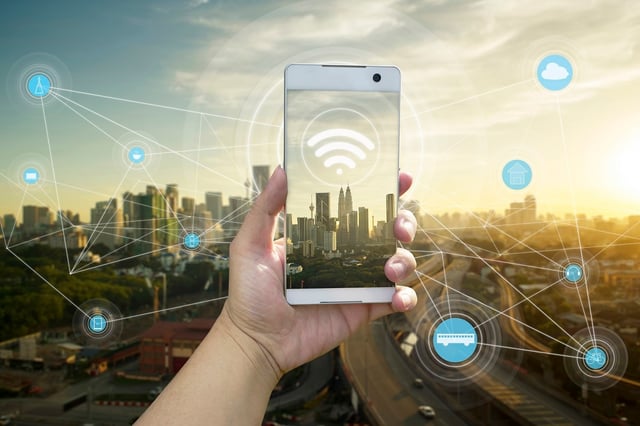There are many ways the IoT can leverage, and be leveraged by, VoIP systems to create a more productive workplace.

Α message we have heard constantly over the past few years, especially those of us within the technology sector, is that in the near future, everything will be connected to everything else. This is a general way of describing what the industry has coined the “Internet of Things” (IoT). Rather than a new set of technologies, the IoT is a radical paradigm shift that has far-reaching implications for almost every business domain. Its influence over Voice over IP (VoIP) telephone systems can be clearly seen. Let’s take a look at what the IoT really is and how it can work together with VoIP.
What is the IoT?
Wikepedia defines the IoT as the “inter-networking of physical devices, vehicles (also referred to as "connected devices" and "smart devices"), buildings, and other items embedded with electronics, software, sensors, actuators, and network connectivity which enable these objects to collect and exchange data.” These can be stand-alone devices specifically designed for the Internet of Things such as smart sensors (e.g. temperature, light, humidity, motion, CO2, wind), smart imaging and audio devices (e.g. video camera, microphone, still-image camera), smart actuators (devices that move things such as an electric motor or hydraulic piston); or they can be equipment and appliances that have been around for years but have been made “smart” by the addition of electronics and software. Such devices could include a car, a washing machine, a traffic light or a home alarm system.
The connectivity of these devices allows them to be controlled remotely, either individually or en masse, by a remote human being or, more commonly, by a centralized control system – or even by other connected devices. Additionally, these smart devices can send information such as temperature, status, video, sound, text, images, statistics and just about any kind of digitizable data to a data repository for later processing and analysis, or to a dashboard to be viewed in real time.
A common example of a real-world application is a smart home or workplace, where anything electronic or electric, from your bathroom scale to your sprinkler system or powered window shutters, could become a smart connected device. These can then be controlled remotely, say from your smartphone, or programmed to react based on information from other devices or systems. For example, if the temperature goes up in one room beyond a certain threshold, awnings can automatically come down on that side of the building to provide shade and lower the temperature. If the resulting temperature drop is insufficient, the cooling system can then kick in.
This is just one example of an unimaginably vast number of applications that exist for the IoT. But how can the IoT be integrated with VoIP to provide a better and more productive workplace?
VoIP and the IoT
Because the IoT and VoIP are both based on the same communications infrastructure – namely, IP – they can easily be made to interact. The best way to understand how the IoT and VoIP can work together is to give some practical examples:
- Using the smart home example described above, IoT devices (actuators, switches, household appliances and heating systems, for example) can accept voice commands over the phone. Because telephones are ubiquitous, even if you have no internet access where you are, you can still call in and command the heating system so that your home will be warm when you arrive on that cold winter’s night. Or, when you’re on vacation, you can order your sprinkler system to start watering so you can return to a lush green lawn. Click here to browse our diverse range of sensors.
- VoIP most commonly uses Session Initiation Protocol (SIP) as its underlying protocol, and SIP has many other functionalities beyond the packetization of voice. Using SIP’s presence capabilities, you can enhance a VoIP presence system to include information that comes from sensors, making presence information even richer and more granular. Click here to learn more about SIP presence.
- SIP also supports video telephony, and IoT imaging devices can be configured to function as SIP endpoints so that a user can view the video feed from that device on a VoIP telephone or mobile phone simply by dialing its telephone number. We carry a wide range of video surveillance and conferencing solutions that are IoT-enabled, including Grandstream cameras, video phones and video conferencing systems; Yealink video phones and video conferencing solution; video cameras and door phones from 2N, CyberData, and Valcom; and security systems from ALC.
- A sensor on the factory floor can make a VoIP telephone call based on predefined criteria that can automatically trigger specific workflows, such as the reordering of components, either because they’re running low or because of defects on a recent batch of products, for example.
CONCLUSION
While VoIP and the IoT have not been fully integrated yet, the potential is definitely there, and we will see a greater level of integration as both technologies continue to mature at home and in the workplace. The recommended blog posts below feature more examples of accessories and appliances that can be connected to your VoIP phone system. What are some examples of connected devices in your workplace? Tell us about it in the comments section.
You may also like:
Are you still only using your IP PBX for voice communications?
Beef up your SIP phone system with these productivity-enhancing accessories
Sizzling trends in business telephony









Comments